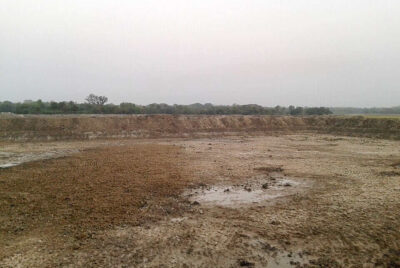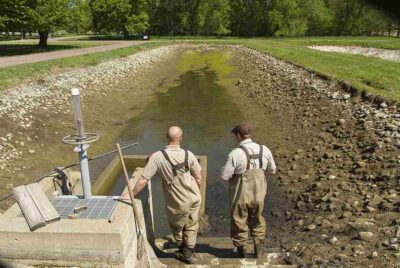How to Fix a Leaking Pond
A leaking pond can be a significant cause of concern for homeowners and property managers. The issue can lead to a host of problems such as a marshy yard, increased water bills, and elevated stress levels. This comprehensive guide is designed to enlighten you on the various strategies on how to fix a leaking pond and restore its aesthetic appeal.
Understanding the Causes of Pond Leaks
Before delving into the various ways of fixing a leaking pond, it’s crucial to understand the root causes of pond leaks. Often, these leaks stem from issues with the pond liner, which serves as a barrier between the water and the soil. There are several causes for pond liner leaks, which include areas with low liners, roots or animals piercing the liner, leaves or algae damming up an area, or having a stream bed that’s too shallow.
Leaks can also occur due to porous soils in the pond’s bottom or improper installation of the dam, overflow, or drain pipe. A pond built on improper soil types, such as sandy soil, can also be prone to leaks due to poor compaction.
Identifying Pond Leaks
The first step in fixing a leaking pond involves identifying the source of the leak. If your pond is losing water, it can potentially simplify this process. Here’s a simple step-by-step guide:
- Relocate your fish into a different tub filled with their previous water in case the leak is near the pond’s base
- Switch off the system and any additional features like an auto-fill device
- Refill the pond to its normal water level
- Allow the pond water to drain
- Once the water stops draining, inspect the water line for the leak’s source. It could be low edges, tears in the pond liner, failed skimmer seals, etc.
If the water’s level only drops a bit or doesn’t drop at all, the leak isn’t in the pond basin. This implies it’s somewhere else, and you’ll have to find it using a different method. Often, leaks are detected by searching on hands and knees while inspecting the pond liner for any damages.
The Milk or Dye Method
You can use non-toxic dye or a gallon of milk to identify a pond leak. Pour the colored liquid from the top of the feature and observe its flow. It’s likely to leak out with the other water where the damage is. Once you identify the leak, you can determine the most suitable repair method.
Repairing a Leaking Pond Using Liquid Rubber Products
One of the popular ways to fix a pond liner leak involves the use of a specific liquid rubber product. Here’s a step-by-step guide:
- Drain the pond water to about 6 inches
- Remove any fish and plants
- Put the fish in a shaded tub filled with their pond water
- Drain the remaining water
- Clean the pond bottom to get rid of muck, sediment, and other debris
- If there are any repair patches, remove them
- Pressure-wash the pond liner
- Allow it to dry completely
- Apply a liquid rubber seam tape on the damaged area
- If you have an EPDM liner, clean it with acetone and then use a liquid rubber EPDM primer
- Apply a liquid rubber sealant to the affected area using a sprayer, roller, or brush
- Allow the coat to dry completely
- Apply 2 to 3 more coats until you achieve a 30 mil. thick membrane
- Wait for 3 to 5 days for it to dry
- Refill your pond
- Wait for 24 to 48 hours to check if there are still any leaks
- Treat the water to make it safe for your fish
- Return your plants
- Properly reintroduce your fish to the water
Other Techniques to Fix a Pond Leak Based on the Type of Damage
Before fixing the leak, ensure you address whatever caused it, such as a tree root growing through the liner. Here are some methods to fix common leaky pond problems:
Using Pond Sealant for Small Holes
If the damage to your pond liner is only 1 to 2 inches, using a pond sealant is a great solution. Pond sealants are safe for both fish and plants. Here’s how to apply it:
- Remove fish and plants
- Drain your pond
- Dry the damaged area
- Apply the sealant as per the instructions
- Wait for it to cure
The curing process can take up to 8 hours. If you have fish, it’s advisable to begin this process early in the day to avoid leaving the fish in a tub overnight. They’ll need shade and an aerator to stay comfortable.
4.2 Using Repair Kits for Larger Holes
Repair kits can patch holes ranging from 2-by-2 inches to 30-by-30 inches. Most kits come with a primer, a sticky patch, and a roller. Here’s how to apply it:
- Remove fish and plants
- Drain your pond
- Dry the damaged area
- Apply the primer
- Cut the patch into a circle
- Apply the patch using the roller
- Wait for it to set
Patches usually blend in well, making it difficult for anyone to notice where it’s applied.
Adding Pond Liner
Sometimes, you might need to add more pond liner. In such cases, you can use joining tape, which is sticky on both sides, allowing you to join two liners. Here’s how to do it:
- Clean and dry the pond liner
- Apply the primer
- Use the joining tape on the liners
- Allow it to set
- Put it back into place
Ensure you reinforce the area sufficiently to avoid fixing one leak and then having another one occur.
Dealing with Extra Large Pond Liner Damage
If your pond liner is extensively damaged and beyond repair, you may need to replace it. This process entails draining the entire pond, removing anything on the liner, and replacing it.
Solutions for Leaks in Large Ponds – (How to Fix a Leaking Pond)
These solutions are more suited for larger backyard and farm ponds compared with backyard garden ponds and koi ponds.
Adding Water – (How to Fix a Leaking Pond)
Although not a permanent solution, if your pond is large and the leak is minor, you can pump in water overnight. However, check with local authorities to see if you need a permit, especially if your groundwater withdrawals exceed 10,000 gallons daily.
Compacting the Soil – (How to Fix a Leaking Pond)
In some cases, a leak could be due to loose or aerated soil that lets water seep through. Fixing this is a substantial project. You’ll first need to drain the pond fully. Then, remove debris at the bottom of the pond, till the bottom 12 to 16 inches deep, and compact the bottom with a roller. The compacted layer should be 6 inches in shallower areas and 12 inches in deeper ones, usually 10 feet and deeper.
Adding Clay – (How to Fix a Leaking Pond)
Clay isn’t permeable, meaning water can’t seep through it. This makes it ideal for stopping leaks in ponds. You’ll need to follow the same process as with compacting the soil. The material you add needs to be at least 20% clay. It’s preferable to spread it in 1-foot layers after you compact it.
Using Bentonite – (How to Fix a Leaking Pond)
Bentonite, a clay-like material that expands when wet, is ideal for sealing cracks and holes. To fix a pond leak with bentonite, first, ensure the area around the leak is dry. Then, apply a layer of bentonite to the area and wait for it to dry. Once it has dried, you can then add water to the pond. The bentonite will swell and seal the leak. While it is not a permanent fix, it can help to prevent further leakage and damage to your pond.
Using Chemicals – (How to Fix a Leaking Pond)
There are various chemicals that you can add to the soil in and around the pond to help fix leaks. One of these is sodium polyphosphate, an inorganic compound made up of sodium, phosphorus, and oxygen. It helps to bind the soil particles together, making the soil less likely to erode.
Adding a Liner – (How to Fix a Leaking Pond)
Adding a plastic or vinyl liner is one of the most effective ways to fix a pond leak. The liner will create a barrier between the water and the soil, preventing further leakage. While it’s a highly effective method, it’s also on the expensive side.
Expert Help for Fixing Pond Leaks
If you have a pond on your property, it’s vital to ensure that it is properly sealed and waterproof. Such a task calls for the need to seek expert help. Companies like Premier Ponds have the expertise and equipment to quickly find and repair any leaks in your pond. They can quickly find and fix any pond leaks, saving you time and stress.
Preventive Measures
The best way to address a leaking pond is to prevent the issue from occurring in the first place. This involves proper pond construction, which includes understanding the soil types, proper installation of the dam, overflow, and drain pipe, and ensuring the pond liner is properly installed and free from any damage.
Dealing with Porous Soils
Even the best dam cannot always compensate for porous soils at the bottom of the pond. In such cases, products like sodium bentonite, clay, hay, organic matter, tires can be used. However, the most important thing is to plug the leak. For this reason, it’s crucial to find the source of the leak.
When to Use a Full Rubber Liner
In some cases, a full rubber liner over the entire pond is the only sure answer to prevent leaks. However, this is a costly option due to the cost of materials and the application process.
Conclusion
A leaking pond can lead to a myriad of problems, from structural damage to the surrounding area to serious health risks for your fish and other aquatic creatures. However, with the right knowledge and approach, you can effectively fix a leaking pond and restore its aesthetic appeal. Whether you opt to use liquid rubber products, pond sealants, repair kits, or enlist the help of experts, the most important thing is to ensure your pond is adequately sealed to prevent any future leaks.
Frequently Asked Questions
Q: How do I know if my pond is leaking?
A: If your pond’s water level drops more than 1/2 inch daily, it could be a sign that your pond is leaking. Other signs include a swampy yard, increased water bills, and visible damage to the pond liner.
Q: What causes pond leaks?
A: Pond leaks can be caused by several factors such as damage to the pond liner, improper installation of the dam, overflow, or drain pipe, or porous soils in the pond’s bottom.
Q: What is the best way to fix a leaking pond?
A: The best way to fix a leaking pond depends on the nature and extent of the leak. Options range from using liquid rubber products and pond sealants to repair kits, adding more pond liner, or even enlisting the help of experts.
Q: Can I fix a leaking pond without draining it?
A: Yes, it’s possible to fix a leaking pond without draining it. Methods such as the milk or dye method, using bentonite, and adding water can be used to fix a leak without having to drain the pond.
Q: How much does it cost to fix a leaking pond?
A: The cost of fixing a leaking pond can vary greatly depending on the nature and extent of the leak, the method used to fix the leak, and whether or not professional help is enlisted. It’s always best to get a quote from a professional service to understand the potential costs.




